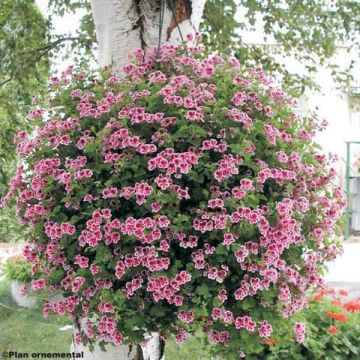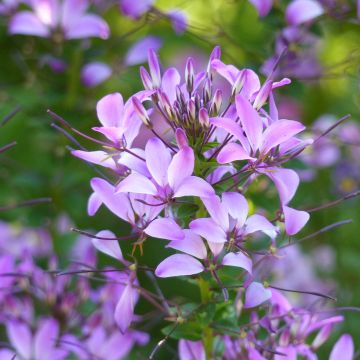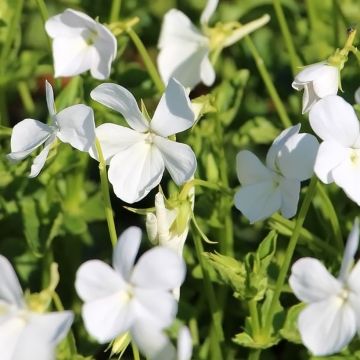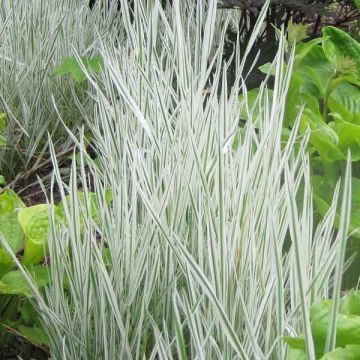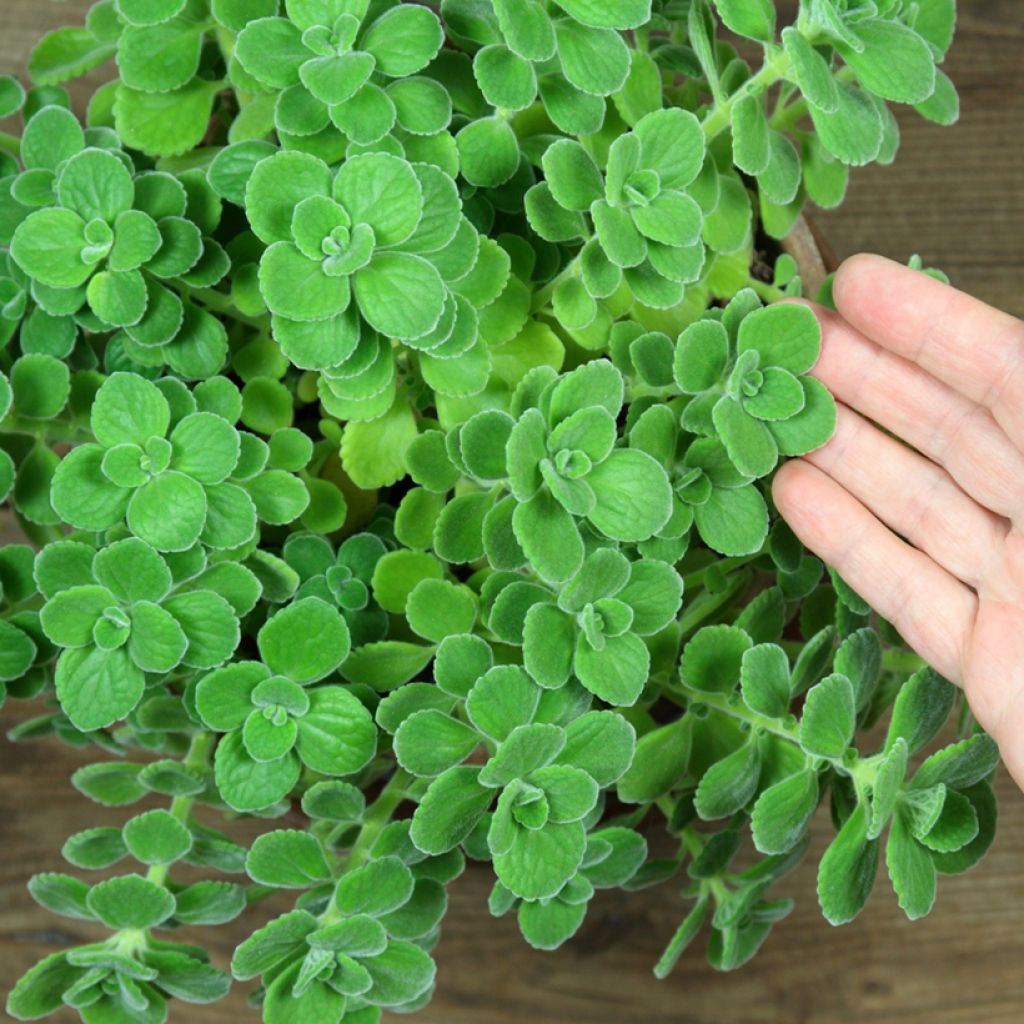

Cuban oregano - Plectranthus amboinicus


Cuban oregano - Plectranthus amboinicus
Cuban oregano - Plectranthus amboinicus
Plectranthus amboinicus
Cuban oregano, Indian borage, Mexican mint, Spanish thyme
This item cannot be shipped to the selected country
Delivery charge from €5.90
More information
Schedule delivery date,
and select date in basket
This plant carries a 6 months recovery warranty
More information
We guarantee the quality of our plants for a full growing cycle, and will replace at our expense any plant that fails to recover under normal climatic and planting conditions.
From €5.90 for pickup delivery and €6.90 for home delivery
Express home delivery from €8.90.
Does this plant fit my garden?
Set up your Plantfit profile →
Description
The Plectranthus amboinicus, renamed Coleus amboinicus, is known as Cuban Oregano or Big Thyme in the Caribbean. It is a perennial and tender aromatic plant, commonly found in the wild in Africa, India, or the Caribbean, cultivated as an annual in our climates. It forms a shrub with fleshy stems bearing succulent, thick, and fuzzy leaves, ranging from light green to greyish-green. They release a fresh and pungent aroma, reminiscent of oregano or thyme. It is grown in pots or in the ground as an annual, and its leaves are harvested from April to November. The leaves are used fresh or dried, in cooking or as a herbal tea, for their aromatic or medicinal properties.
The Plectranthus amboinicus belongs to the Lamiaceae family. It is a herbaceous perennial plant native to southern and eastern Africa to the Arabian Peninsula and India, where it grows in woodlands or coastal shrubs, on rocky slopes and sandy or loamy plains at low altitudes. The plant was later introduced to Europe, then from Spain to the Americas. The Coleus amboinicus forms a shrub that can reach 1 m in height in the wild. When grown here, it will not exceed 40 cm in height. Its fleshy stems are hairy and highly branched. They bear numerous opposite leaves, oval to rounded in shape, with finely crenate margins. They are thick and pubescent, with the underside having the most glandular hairs, giving them a frosted appearance. The aroma of the leaves can be described as a pungent combination of oregano, thyme, and turpentine scents. The taste of the leaves is described as similar to oregano but with a pungent flavour reminiscent of mint. The flowers bloom in late summer, on a short, pale purple stem, in dense whorls of flowers on a long, thin spike-shaped raceme. The plant is frost-sensitive.
The Plectranthus amboinicus is also known as Indian Mint or Ear. It is sometimes confused with Lippia micromera or Antillean Thyme. It thrives in poor, dry, well-drained soil, in sunny or partially shaded positions during hot weather. Cut leafy stem sections as needed. When not used for its aromatic properties in cooking, for marinades, soups, and fish for example, it is attributed medicinal properties for digestive issues, respiratory conditions, flu-like symptoms, or disturbed sleep.
Report an error about the product description
Flowering
Foliage
Plant habit
Botanical data
Plectranthus
amboinicus
Lamiaceae
Cuban oregano, Indian borage, Mexican mint, Spanish thyme
Coleus amboinicus, Plectranthus aromaticus
South Africa
Other Annuals A to Z
Planting and care
Plectranthus amboinicus prefers sunny exposures, but appreciates partial shade during hot periods. It grows in dry and well-drained soil, even poor soil. You can plant it in April, after the last frosts, in a pot or even in the ground. It is a very sensitive plant that does not tolerate temperatures below 4°. You can take it out to the garden from May onwards and bring it back into a bright veranda or room before the first frosts. If the plant spends the winter indoors, watering should be reduced. It propagates easily at any time by propagation by cuttings (cuttings 15 to 20 centimeters long). It requires little maintenance: regularly pinch the stems so that the plant maintains a compact habit.
Planting period
Intended location
Care
This item has not been reviewed yet - be the first to leave a review about it.
Plug plants - Annuals
Haven't found what you were looking for?
Hardiness is the lowest winter temperature a plant can endure without suffering serious damage or even dying. However, hardiness is affected by location (a sheltered area, such as a patio), protection (winter cover) and soil type (hardiness is improved by well-drained soil).

Photo Sharing Terms & Conditions
In order to encourage gardeners to interact and share their experiences, Promesse de fleurs offers various media enabling content to be uploaded onto its Site - in particular via the ‘Photo sharing’ module.
The User agrees to refrain from:
- Posting any content that is illegal, prejudicial, insulting, racist, inciteful to hatred, revisionist, contrary to public decency, that infringes on privacy or on the privacy rights of third parties, in particular the publicity rights of persons and goods, intellectual property rights, or the right to privacy.
- Submitting content on behalf of a third party;
- Impersonate the identity of a third party and/or publish any personal information about a third party;
In general, the User undertakes to refrain from any unethical behaviour.
All Content (in particular text, comments, files, images, photos, videos, creative works, etc.), which may be subject to property or intellectual property rights, image or other private rights, shall remain the property of the User, subject to the limited rights granted by the terms of the licence granted by Promesse de fleurs as stated below. Users are at liberty to publish or not to publish such Content on the Site, notably via the ‘Photo Sharing’ facility, and accept that this Content shall be made public and freely accessible, notably on the Internet.
Users further acknowledge, undertake to have ,and guarantee that they hold all necessary rights and permissions to publish such material on the Site, in particular with regard to the legislation in force pertaining to any privacy, property, intellectual property, image, or contractual rights, or rights of any other nature. By publishing such Content on the Site, Users acknowledge accepting full liability as publishers of the Content within the meaning of the law, and grant Promesse de fleurs, free of charge, an inclusive, worldwide licence for the said Content for the entire duration of its publication, including all reproduction, representation, up/downloading, displaying, performing, transmission, and storage rights.
Users also grant permission for their name to be linked to the Content and accept that this link may not always be made available.
By engaging in posting material, Users consent to their Content becoming automatically accessible on the Internet, in particular on other sites and/or blogs and/or web pages of the Promesse de fleurs site, including in particular social pages and the Promesse de fleurs catalogue.
Users may secure the removal of entrusted content free of charge by issuing a simple request via our contact form.
The flowering period indicated on our website applies to countries and regions located in USDA zone 8 (France, the United Kingdom, Ireland, the Netherlands, etc.)
It will vary according to where you live:
- In zones 9 to 10 (Italy, Spain, Greece, etc.), flowering will occur about 2 to 4 weeks earlier.
- In zones 6 to 7 (Germany, Poland, Slovenia, and lower mountainous regions), flowering will be delayed by 2 to 3 weeks.
- In zone 5 (Central Europe, Scandinavia), blooming will be delayed by 3 to 5 weeks.
In temperate climates, pruning of spring-flowering shrubs (forsythia, spireas, etc.) should be done just after flowering.
Pruning of summer-flowering shrubs (Indian Lilac, Perovskia, etc.) can be done in winter or spring.
In cold regions as well as with frost-sensitive plants, avoid pruning too early when severe frosts may still occur.
The planting period indicated on our website applies to countries and regions located in USDA zone 8 (France, United Kingdom, Ireland, Netherlands).
It will vary according to where you live:
- In Mediterranean zones (Marseille, Madrid, Milan, etc.), autumn and winter are the best planting periods.
- In continental zones (Strasbourg, Munich, Vienna, etc.), delay planting by 2 to 3 weeks in spring and bring it forward by 2 to 4 weeks in autumn.
- In mountainous regions (the Alps, Pyrenees, Carpathians, etc.), it is best to plant in late spring (May-June) or late summer (August-September).
The harvesting period indicated on our website applies to countries and regions in USDA zone 8 (France, England, Ireland, the Netherlands).
In colder areas (Scandinavia, Poland, Austria...) fruit and vegetable harvests are likely to be delayed by 3-4 weeks.
In warmer areas (Italy, Spain, Greece, etc.), harvesting will probably take place earlier, depending on weather conditions.
The sowing periods indicated on our website apply to countries and regions within USDA Zone 8 (France, UK, Ireland, Netherlands).
In colder areas (Scandinavia, Poland, Austria...), delay any outdoor sowing by 3-4 weeks, or sow under glass.
In warmer climes (Italy, Spain, Greece, etc.), bring outdoor sowing forward by a few weeks.



































